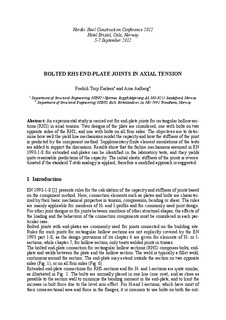| dc.contributor.author | Aalberg, Arne | nb_NO |
| dc.contributor.author | Torp Karlsen, Fredrik | nb_NO |
| dc.date.accessioned | 2014-12-19T11:19:54Z | |
| dc.date.available | 2014-12-19T11:19:54Z | |
| dc.date.created | 2013-03-22 | nb_NO |
| dc.date.issued | 2012 | nb_NO |
| dc.identifier | 612513 | nb_NO |
| dc.identifier.isbn | 978-82-91466-12-5 | nb_NO |
| dc.identifier.uri | http://hdl.handle.net/11250/228203 | |
| dc.description.abstract | An experimental study is carried out for end-plate joints for rectangular hollow sections (RHS) in axial tension. Two designs of the plate are considered; one with bolts on two opposite sides of the RHS, and one with bolts on all four sides. The objectives are to determine how well the yield line mechanisms model the capacity and how the stiffness of the joint is predicted by the component method. Supplementary finite element simulations of the tests are added to support the discussion. Results show that the failure mechanisms assumed in EN 1993-1-8 for extended end-plates can be identified in the laboratory tests, and they yields quite reasonable predictions of the capacity. The initial elastic stiffness of the joints is overestimated if the standard T-stub analogy is applied; therefore a modified approach is suggested. | nb_NO |
| dc.language | eng | nb_NO |
| dc.publisher | Norwegian Steel Association | nb_NO |
| dc.title | Bolted RHS end-plate joints in axial tension | nb_NO |
| dc.type | Chapter | nb_NO |
| dc.description.version | publishedVersion | |
| dc.source.journal | Proceedings of Nordic Steel Construction Conference | nb_NO |
